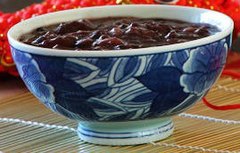Laba Festival (Chinese: 臘八節) is a traditional Chinese holiday celebrated on the eighth day of the month of La (or Layue 臘月), the twelfth month of the Chinese calendar. It is the beginning of the Chinese New Year period. It is customary on this day to eat Laba congee.
| Laba Festival | |
|---|---|
 A bowl of Laba congee. | |
| Official name | Làbā Jié (臘八節, 腊八节) |
| Observed by | Chinese |
| Significance | Celebration of the end of the year, celebration of the enlightenment of the Buddha |
| Observances | Consumption of Laba congee, etc. |
| Date | 8th day of the 12th lunar month |
| 2023 date | 18 January |
| 2024 date | 18 January |
| 2025 date | 7 January |
| Related to | Bodhi Day Rohatsu (in Japan) Other related festivals Vesak (in Sri Lanka, Myanmar, Thailand, Cambodia, Laos) |
| Laba Festival | |||||||||||||||||
|---|---|---|---|---|---|---|---|---|---|---|---|---|---|---|---|---|---|
| Traditional Chinese | 臘八 | ||||||||||||||||
| Simplified Chinese | 腊八 | ||||||||||||||||
| Literal meaning | "Eighth of La" | ||||||||||||||||
| |||||||||||||||||
Laba Festival was not on a fixed day until the Southern and Northern dynasties, when it was influenced by Buddhism and was fixed on the eighth day of twelfth month, which was also the enlightenment day of the Buddha. Therefore, many customs of the Laba Festival are related to Buddhism. It corresponds directly to the Japanese Rohatsu and the South Asian Bodhi Day.
History
editThe Laba Festival's name represents its date on the Chinese calendar. La is the name of the twelfth and final month, and ba means "eight".[1] In ancient China, the "eight" referred to making sacrifices to eight gods at the end of the year.[2]
In its original form, the festival was celebrated by making sacrifices to gods and ancestors to wish for good fortune, health, safety, and a good harvest in the new year.[3][2] The word la originally referred to these sacrifices.[3]
After Buddhism spread to China during the first century CE, the festival was used as commemoration of Gautama Buddha's enlightenment.[2] It was given a fixed date (the eighth day of the twelfth month) during the Northern and Southern dynasties.[3]
During the Qing dynasty, ceremonies for the Laba festival were held at the Yonghe Temple in Beijing.[4]
Customs
editLaba Festival is considered the prelude to Chinese New Year, which falls about three weeks later.[3][5]
An old custom is beating drums to drive away diseases. This practice, which originated from ancient traditions of witchcraft, is still observed in places such as Xinhua, Hunan.[6]
Laba congee
editTraditionally, the consumption of Laba congee is an important element of the festival. There are multiple legendary accounts of the dish's origins.[7] One story says that it originated in the Song dynasty with Buddhist monasteries giving congee to people in honor of the story that Sakyamuni (Gautama Buddha) reached enlightenment on the eighth day of the twelfth month after eating congee.[2]
Laba congee or Laba porridge (臘八粥; Làbāzhōu) is very popular in many places in China. Different kinds of rice, beans, nuts and dried fruits are the main ingredients. People believe that it's good for health in the winter.[1]
It is also known as "eight-treasure congee" (八宝粥; Bā bǎo zhōu)[8] and is usually made with eight or more ingredients, representing good luck.[1] Eight is a lucky number in China,[9] and the ba in Laba also means eight.[1]
There are many variations of Laba congee in different regions of China.[7] Ingredients can include mixed grains, such as rice, millet, and barley; beans and nuts such as mung beans, azuki beans, lotus seeds, peanuts, walnuts, and chestnuts; dried fruit such as red dates, longan, raisins, and goji berries; and other ingredients such as vegetables and meat.[8][10][6][7]
Laba garlic
editAnother Laba food is Laba garlic, which is particularly popular in northern China.[11] Garlic in Chinese (蒜; suàn) has the same pronunciation as calculate (算; suàn), and it is said that on the Laba Festival businesses should balance their books and calculate their revenues and expenditures for the year.[8] Laba garlic is made by soaking garlic in vinegar.[6] Laba garlic is soaked in vinegar from the Laba Festival until Chinese New Year. The garlic and vinegar are then used alongside Chinese dumplings (jiaozi) around Chinese New Year.[5]
In popular culture
editThe festival is relevant to the plot of Jin Yong's novel Ode to Gallantry.
In 2011, Google published a Google Doodle commemorating the festival.[12]
See also
editReferences
edit- ^ a b c d "'Eight treasure congee' shines during Laba Festival". www.chinadaily.com.cn. Retrieved 22 November 2022.
- ^ a b c d Guang, Xing (November 2013). "Buddhist Impact on Chinese Culture". Asian Philosophy. 23 (4): 305–322. doi:10.1080/09552367.2013.831606. S2CID 145072418. Retrieved 22 November 2022.
- ^ a b c d "The Laba Festival". www.magzter.com. Retrieved 22 November 2022.
- ^ "新年纳余庆 嘉节启新芳——古诗词里的春节习俗". guoqing.china.com.cn. Retrieved 22 November 2022.
- ^ a b Gong, Wen (2007). Lifestyle in China. 五洲传播出版社. p. 14. ISBN 978-7-5085-1102-3. Retrieved 23 November 2022.
- ^ a b c "腊八节的传说和习俗(图)". Archived from the original on 2011-01-14.
- ^ a b c Stepanchuk, Carol (1991). Mooncakes and Hungry Ghosts: Festivals of China. San Francisco: China Books & Periodicals. pp. 3–6. ISBN 0-8351-2481-9.
- ^ a b c "农历腊八节:有悠久传统和历史 喝腊八粥腌腊八蒜". 中新网. Retrieved 22 November 2022.
- ^ Hoon Ang, Swee (1 January 1997). "Chinese consumers' perception of alpha-numeric brand names". Journal of Consumer Marketing. 14 (3): 220–233. doi:10.1108/07363769710166800. ISSN 0736-3761. Retrieved 22 November 2022.
- ^ "7 Chinese dishes that are completely plant-based". South China Morning Post. 5 April 2019. Retrieved 22 November 2022.
- ^ Block, E. (2010). Garlic and Other Alliums: The Lore and the Science. Royal Society of Chemistry. ISBN 978-0-85404-190-9.
- ^ "Laba Rice Porridge Festival 2011". Retrieved 11 January 2015.
External links
edit- "腊八节". Netor网同纪念 (in Chinese). Archived from the original on 2010-01-08.
- "沖縄エコツアー-沖縄の風習編". のんびりゆっくり沖縄自然体験エコツアー (in Japanese). Archived from the original on 2008-12-14.